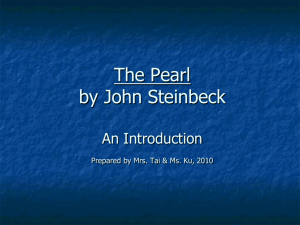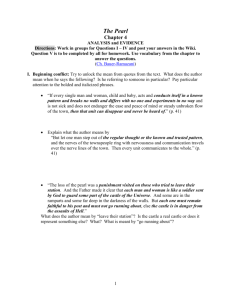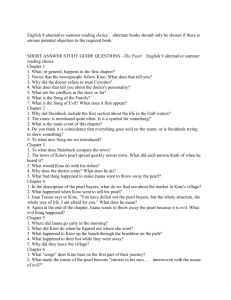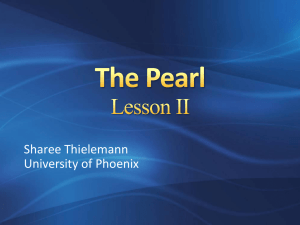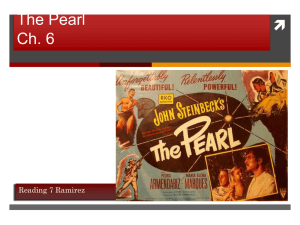The Pearl
advertisement
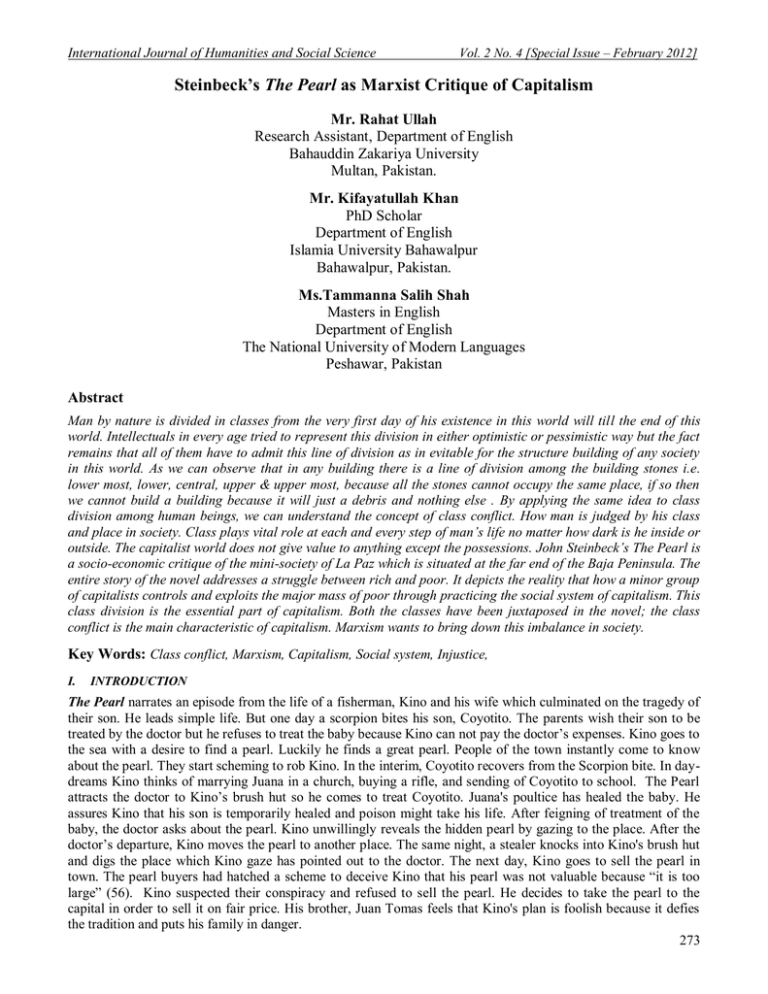
International Journal of Humanities and Social Science Vol. 2 No. 4 [Special Issue – February 2012] Steinbeck’s The Pearl as Marxist Critique of Capitalism Mr. Rahat Ullah Research Assistant, Department of English Bahauddin Zakariya University Multan, Pakistan. Mr. Kifayatullah Khan PhD Scholar Department of English Islamia University Bahawalpur Bahawalpur, Pakistan. Ms.Tammanna Salih Shah Masters in English Department of English The National University of Modern Languages Peshawar, Pakistan Abstract Man by nature is divided in classes from the very first day of his existence in this world will till the end of this world. Intellectuals in every age tried to represent this division in either optimistic or pessimistic way but the fact remains that all of them have to admit this line of division as in evitable for the structure building of any society in this world. As we can observe that in any building there is a line of division among the building stones i.e. lower most, lower, central, upper & upper most, because all the stones cannot occupy the same place, if so then we cannot build a building because it will just a debris and nothing else . By applying the same idea to class division among human beings, we can understand the concept of class conflict. How man is judged by his class and place in society. Class plays vital role at each and every step of man’s life no matter how dark is he inside or outside. The capitalist world does not give value to anything except the possessions. John Steinbeck’s The Pearl is a socio-economic critique of the mini-society of La Paz which is situated at the far end of the Baja Peninsula. The entire story of the novel addresses a struggle between rich and poor. It depicts the reality that how a minor group of capitalists controls and exploits the major mass of poor through practicing the social system of capitalism. This class division is the essential part of capitalism. Both the classes have been juxtaposed in the novel; the class conflict is the main characteristic of capitalism. Marxism wants to bring down this imbalance in society. Key Words: Class conflict, Marxism, Capitalism, Social system, Injustice, I. INTRODUCTION The Pearl narrates an episode from the life of a fisherman, Kino and his wife which culminated on the tragedy of their son. He leads simple life. But one day a scorpion bites his son, Coyotito. The parents wish their son to be treated by the doctor but he refuses to treat the baby because Kino can not pay the doctor‘s expenses. Kino goes to the sea with a desire to find a pearl. Luckily he finds a great pearl. People of the town instantly come to know about the pearl. They start scheming to rob Kino. In the interim, Coyotito recovers from the Scorpion bite. In daydreams Kino thinks of marrying Juana in a church, buying a rifle, and sending of Coyotito to school. The Pearl attracts the doctor to Kino‘s brush hut so he comes to treat Coyotito. Juana's poultice has healed the baby. He assures Kino that his son is temporarily healed and poison might take his life. After feigning of treatment of the baby, the doctor asks about the pearl. Kino unwillingly reveals the hidden pearl by gazing to the place. After the doctor‘s departure, Kino moves the pearl to another place. The same night, a stealer knocks into Kino's brush hut and digs the place which Kino gaze has pointed out to the doctor. The next day, Kino goes to sell the pearl in town. The pearl buyers had hatched a scheme to deceive Kino that his pearl was not valuable because ―it is too large‖ (56). Kino suspected their conspiracy and refused to sell the pearl. He decides to take the pearl to the capital in order to sell it on fair price. His brother, Juan Tomas feels that Kino's plan is foolish because it defies the tradition and puts his family in danger. 273 The Special Issue on Contemporary Issues in Social Science © Centre for Promoting Ideas, USA Juana warns Kino that ―this pearl is evil‖ and ―let us destroy it before it destroys us‖ (64), but he rejects Juana‘s warning and says ―I will win over it. We have our chance‖ (65). That night, Juana secretly steals the pearl and takes the sea route to throw it, but Kino senses her movement and accosts her. He slaps her in the face. On his way back to his hut, Kino is attacked and he also kills the man in self-defense. Juana goes to gather things from the hut to escape. As Juana comes out of the hut someone sets their house on fire. Kino and Juana with their baby take refuge in Juan Thomas‘ house during the day light. They start journey to other city in the darkness. After a half day journey they rest under a shade. Kino finds that trackers are in search of them. He knows the consequences if they are caught by them. To get out of their hold, they run away to the mountains where they hide in a cave at dusk. The trackers also culminate their journey just below their cave in search of them. Kino sneaks down in the dark to get rid of the trackers, but before he can attack them, Coyotito cries out. The trackers take it for the cry of Coyote and fire at that direction. As the shot is fired, Kino springs on the trackers and kills all. Unfortunately, Coyotito is struck by the gunshot and Kino's journey with the pearl ends in tragedy. Feeling that the pearl is cursed and destroyed his family (as Juana forewarned), Kino and Juana take their way back to La Paz with the dead body and the rifle of the trackers and throw the cursed pearl into the sea. II. LITERATURE REVIEWED Twentieth century writers and critics are interested in the class conflict and ups and downs in the society. These writers wrote their works highlighting the inequality in the society and inadequacies of capitalism. Writers like Steinbeck have exposed the exploitation of the poor class of society in America in their novels. Guerin and his co-authors support it.1 Conflicts as we see in The Pearl between the-haves and the-have-nots obsessed the minds of all philosophers, especially of Marxist bent of mind, from Plato down to Lenin. In this respect a notable American Marxist critic Fredric Jameson quotes Marx and Engels themselves in his ‗On Interpretation: Literature as a Socially Symbolic Act‘, as under: The history of all hitherto existing society is the history of class struggles: freeman and slave, patrician and plebeian, lord and serf, guild-master and journeyman—in a word, oppressor and oppressed—stood in constant opposition to one another, carried on an uninterrupted, now hidden, now open fight, a fight that each time ended, either in a revolutionary reconstitution of society at large or in the common ruin of contending classes. (Newton, K.M. 82) The crux of the novel is the proletariat‘s short term glory and its decay at the hands of aristocracy. The very opening words of the prologue of The Pearl indicate that the entire story is woven around the central idea of achieving economic glory for a short time (finding of the great Pearl) and then the crumbling of that glory at the end (death of the Kino‘s baby Coyotito). Thus, the phrases ―the great pearl‖, ―was found‖, and ―was lost‖ in the prologue2, indicate that the main happenings of the story have a direct relation with the economic life of the characters and the setting. ―For Marxism, getting and keeping economic power is the motive behind all social and political activities, including education, philosophy, religion, government, the arts, science, technology, and the media and so on. Thus economics is the base on which the superstructure of social /political/ ideological realities is built.‖ (Tyson: 54) Moreover, the very first words, ―in the town‖ in the prologue, demonstrate that the novel deals with the capitalist activities as cities and towns are usually associated with economic competition of the capitalists and exploitation of the poor and marginalized class of society. In the same prologue the words ―…there are only good and bad things and black and white things and good and evil things and no in-between anywhere‖ indicate that the text has been woven around a class-ridden society wherein a sharp separation of ―good and bad things‖ and an inhuman discrimination on the grounds of ―black and white things‖ could be observed. ‗No in between‘ also indicates that the characters of the novel strictly comprises of two groups that is Bourgeoisie or the-haves and the Proletariat or the have-notes. The darkness of the Capitalist system and Kino‘s resistance to it is evident from the start of the novel. After the prologue, the opening of the novel records, ―Kino awakened in the near dark‖, which implies that the protagonist is the inhabitant of the man-created darkness and he will have to fight against this darkness. When he opens his eyes, first of all he saw ―the lightening square which was the door‖ (p.1), which manifests that the protagonist is not a blind person but is conscious to his exploitation. Moreover, his looks for light indicate that he will try to liberate himself from all kinds of darkness. 274 International Journal of Humanities and Social Science Vol. 2 No. 4 [Special Issue – February 2012] Kino‘s looking towards the door also implies that he will continue his efforts to get rid of various bondages and restrictions imposed upon him by various persons and institutions of his own society. Kino belongs to the exploited strata of the society. He is a representative of the have-nots. In the very first chapter, the author juxtaposes the living conditions of both the haves and the have-nots which prove that the ‗haves‘ exploit the ‗have-nots‘ for their mortal pleasures. Kino lives in a small ―brush house‖ while the doctor and other aristocrats or members of the bourgeoisie reside in city. They are living in: the city of stone and plaster…, the city of harsh outer walls and inner cool gardens where a little water played and the bougainvillea crusted the walls with purple and brick-red and white. They heard from the secret gardens the singing of caged birds and heard the splash of cooling water on hot flag stones (9-10). The ―caged birds‖ in the doctor‘s house suggest that the aristocrats of Kino‘s society not only maltreat their fellows, but they also imprison the innocent creatures of the nature which they use for the decoration and selfpleasure. Further it also suggests that the aristocrats are getting pleasure out of others‘ pains. Moreover, the cage is a mini-prison cell. Prisons are used, rather misused, for the confinement of men, while cages are used for the confinement of birds. Both are misused for the same purposes and the persons or institutions who use such things consider themselves authoritative. In the case of human beings, such institutions like prisons are used to impose various restrictions on them by the persons who are controlling the economy. Such cultural tools or social institutions have been christened as ―Repressive State Apparatuses‖ (ISAs) by Louis Althusser in ―Ideology and the State‘, Lenin and Philosophy and other essays‖. Althusser lists ‗Government, the Administration, the Army, the Police, the Courts, the Prisons‘ etc as the ‗Repressive State Apparatus‘ which ‗functions by violence‘. 3 To what extent the characters in the novel have been deprived of the basic necessities of life? It could be imagined from the wretched conditions of the beasts on the near side of the ghetto: ―…the early pigs were already beginning their ceaseless turning of twigs and bits of wood to see whether anything to eat had been overlooked‖, (p. 1). It seems that pigs are entirely dependent upon the inmates, while the inmates do not give any attention to the wretched conditions of those pigs that are starving from hunger. Further the novelist writes: ―The ants were busy on the ground, big black ones with shiny bodies, and little dusty quick ants. Kino watched with the detachment of god while a dusty ant frantically tried to escape the sand trap, an ant lion had dug for him. A thin, timid dog came close…‖ (3).The ants are considered as the meek and hard working creature of earth. In society we usually associate hard working poor people with ants. Its is said ‗O ant‘, while addressing a poor man ‗it does not matter how much you work hard, your ultimate result will be the same hard work in dust.‘ So the ant symbolizes Kino and his race with their wretched condition like ants. The trap of the lion ant symbolizes the exploitation of poor by the capitalists. Moreover we can observe that most of the beings in the novel are pining after the basic necessities of life. The living conditions of Kino and his race are not much different from these ants. The wretched conditions of the pigs and their ―ceaseless turning of twigs and bits of wood to see whether anything to eat‖, the ants who ―frantically tried to escape the sand trap‖, and the ―thin, timid dog‖, all these things anticipate the high-handedness of the opposing forces of the society. It indicates that the society of The Pearl is economically deprived and its inmates are the victims of exploitations. Moreover, most of the animals of the locality, mentioned in the text, are engaged in an undeclared war against each other: apart from the ants and the ant lions, the novelist further writes: ―Near the brush fence two roosters bowed and feinted at each other with squared wings and neck feathers ruffed out . It would be a clumsy fight‖ (4). Through the wretched condition of the animals of the locality the novelist exemplify the worst condition of Kino‘s race. In the beginning of chapter two we see ―on the beach the hungry dogs and the hungry pigs of the town searched endlessly for any dead fish or sea bird that might have floated in on a rising tide.‖(15) Signify the miserable condition of the animals of the locality. The animals depend on the wasted materials on the beach. In the same way Kino‘s race are marginalized to the beach of the sea and only depended on the sea food like fish or its clumsy pearls. They are silenced by aristocracy of La Paz to use the remaining of the upper class. The gap between the two classes of society becomes more evident when Kino‘s son Coyotito is stung by a scorpion and Juana asks for the services of the doctor of the locality. 275 The Special Issue on Contemporary Issues in Social Science © Centre for Promoting Ideas, USA It was: A wonderful thing, a memorable thing, to want the doctor. To get him would be a remarkable thing. The doctor never came to the cluster of brush houses. Why should he, when he had more than he could do to take care of the rich people who lived in the stone and plaster houses of the town?‖, (8). Thus, we can observe that The Pearl is set in and around La Paz, Mexico, a coastal town marked by economic, social, and racial divisions resulting from colonial domination of the local native population. In other words Kino‘s people are colonized within a state. In the very first chapter of the novel, the novelist juxtaposes: the dominant and the dominated; the oppressor and the oppressed; the haves and the have-nots. Domination of one class by another is the key note of the text. The whole Marxist theory strictly resents the domination and the resultant exploitation of one class by another. What Marx demonstrated was that far from comprising an open and neutral environment the capitalist economy is first and foremost a power structure. The basis of this power structure is class oppression. For Marx, capitalism is a mode of production that revolved around a basic antagonism between two fundamental classes: the bourgeoisie and the workers (or proletariat). As the minority ruling class, the bourgeoisie are defined by their monopolization of the means of production and subsistence (i.e. all that is necessary to make a living: land raw materials, technology and so on). The proletariat, by contrast, comprises the vast majority and is defined precisely in terms of their lack of access to means of production‖. (Glyn Daly: 29) The novelist has depicted Kino and his family realistically. He has duly emphasized their wretched economic condition of Kino. When Kino awake, get up and go to the fire-place for his break-fast, he ―squatted by the fire pit and rolled a hot corn-cake and dipped it in sauce and ate it. And he drank a little plaque and that was break-fast. That was the only break-fast he had ever known outside of feast days‖, (4). At another place he portrays the economic situation of the family in these words: ―And the newcomers, particularly the beggars from the front of the church who were great experts in financial analysis, looked quickly at Juana‘s old blue skirt, saw the tears in her shawl, appraised the green ribbon on her braids, read the age of Kino‘s blanket and the thousand washings of his clothes, and set them down as poverty people…‖, (10). When Kino and Juana, along with the neighbours, went to ―the city of stone and plaster‖ to get the services of the doctor for the treatment of their little Coyotito, most of the neighbours were keen to know ―what the fat lazy doctor would do about an indigent baby with a scorpion bite‖, (11). Thus, the novelist has amply clarified the poverty-stricken situation of all the three members of the family in a pathetic and heart-rending way. Kino, his wife Juana, Juan Tomas, Apolonia and their neighbours living in the brush houses are the characters who represent one class of the society: the oppressed, the exploited, the victims. In Marxist theory, they are known as workers or proletariat. All these are the dire consequences of the nineteenth century industrialism and the resultant capitalism. Thus, chapter one is a background to the forthcoming friction between Kino as protagonist on one side, while the opposing forces of the society as antagonist on the other side. The society has been segregated on economic bases, and the ―economic base‖ has been described as the ―starting-point‖ in Marxism. The finding of the great pearl aroused strange sensation in all people of La Paz and they start scheming how to get profit out of the pearl. They started taking interest in Kino. Everyone tries to associate oneself with the business of the pearl. The priest of the church is the first who come to know about the pearl. He starts day-dreaming about the alms that Kino may give to the church. Shopkeepers sitting in their shops examine the clothes with the prospect that Kino may buy clothes out of the pearl money. The doctor who had refused to treat Kino‘s son claims that Kino is his client and he is treating Kino‘s son for scorpion bite. The doctor recalls his luxuriant life in the Paris. All this happened as a result of the pearl which manifests wealth and money. These people thought in terms of exploitation of Kino. The priest, shopkeepers and the doctor who are from the bourgeoisie class want to snatch back the pearl or its money out of Kino‘s hand which nature has bestowed upon Kino. Accordingly, the local priest begins to take special interest in Kino. He visited Kino that night. The novelist writes: ―The priest came in—a graying, ageing man with an old skin and a young sharp eye. Children he considered these people.‖ (31). It indicates the hypocrisy of the clergy. He congratulates Kino that he is named after the name of a great priest. 276 International Journal of Humanities and Social Science Vol. 2 No. 4 [Special Issue – February 2012] Due to such reasons, Marx abhors such institutions, while another icon of the twentieth century Marxist criticism and the well-known French Marxist theoretician, Louis Althusser categorizes such institutions under his own devised Ideological State Apparatuses (ISAs) which are used for the domination and exploitation of the citizens in a capitalist system. The parasites of the Proletariats are not far than the bourgeoisie in the exploitation of the poor people. The beggars sitting in front of the church are motivated by the news of the pearl and hope of alms. They celebrate their happiness when: ―The news came early to the beggars in front of the church, and it made them giggle a little with pleasure, for they knew that there is no alms-giver in the world like a poor man who is suddenly lucky.‖ (P: 25) The next group of parasites is that of pearl buyers who used to buy pearls from the poor fishermen. ―There were only one [pearl buyer], and he kept these agents in separate offices to give a semblance of competition‖ (25-26). The pearl buyer used to exploit the poor fishermen for their owner to gain their commission out of the profit: ―They waited in their chairs until the pearls came in and then they cackled and fought and shouted and threatened until they reached the lowest price the fisher man would stand‖ (P: 25). When Kino went to sell his pearl in the nearby market, the novelist sketches secret practice of the pearl-dealers in these words: The news of the approach of the procession ran ahead of it, and in their little dark offices the pearl buyers stiffened and grew alert. They got out papers so that they could be at work when Kino appeared, and they put their pearls in the desks, for it is not good to let an inferior pearl be seen beside a beauty. (47-53). Kino‘s imagination is also at work due the excitement of finding a good fortune. He sees the pictures of those things in the surface of the pearl which he thought in the past but gave up as impossible. The pearl becomes a sign to liberate him from the unseen prison constructed by capitalists of La Paz. The things which were associated with bourgeoisie seemed possible for him now. Kino in his imagination sees himself before the altar in the church and says to Juana ―We will be married – in the church‖. ―In the pearl he sees how they were dressed. ‗We will have new clothes‖. (27-28). In the same way he innocently desired for many things he will do by the money of the pearl. But as long as he will not have a rifle, he will not be able to liberate himself from the slavery. But to wage war against capitalism is not an easy job as ―It was the rifle that broke down the barriers. This was an impossibility, and if he could think of having a rifle whole horizons were burst and he could rush on‖ (28). Capitalist Ideology foregrounds in the exploitation of the proletariat in The Pearl. Kino and his race held certain views which are evidently capitalist Ideology. Tyson writes ―Undesirable ideologies promote repressive political agendas and, in order to ensure their acceptance among the citizenry, pass themselves off as natural ways of seeing the world instead of acknowledging themselves as ideologies‖. In the novel Kino and Juana are reluctant to show the baby to the doctor when he comes at their hut. But when the doctor declares that it may be a temporary improvement and he ―shifted his small black doctor‘s bag about so that the light of lamp fell upon it, for he knew that Kino‘s race love the tools of any craft and trust them‖ (34). In this way Kino is duped by the doctor to check the baby. The doctor gives such medicine to the baby which vomited the baby and proved that the baby is ill. In addition to this Kino‘s neighbours believed that sudden wealth might make a poor man greedy, hateful and cold. They wished Kino to be safe from the evil effects of wealth. The have-nots had made the proletariat to hate wealth and money which was extra of their needs. After first attack on Kino to steal the pearl Juana said to Kino that the pearl is evil and ―throw it [pear] away. Let us break it between stones. It will destroy us all‖ (64) but Kino is not ready in anyway to this version of ideology, as the pearl in itself is not evil but Kino and his people are made disgusted to good fortune. Further we see that the capitalists had no regard for human beings but for material entity. When Kino kills a man in self defense, he makes his way to the beach to prepare his canoe for escape. But a hole was knocked in the bottom of his canoe. In utter distress Kino gave expression to his feelings which are installed by the repressive ideology of the capitalists. ―The killing of man was not so evil, as the killing of a boat, for a boat does not have sons, and a boat cannot protect itself, and a wounded boat does not heal‖(71). His boat was his only defense against hunger and extinction. Kino and his race were colonized by the Capitalists of La Paz from the past. They were marginalized, exploited and alienated by the bourgeoisie. Due to the fear of oppression and harassment, psychological disorders can also be traced in them. There only defense is to shut or squint their eyes against the harsh realities. 277 The Special Issue on Contemporary Issues in Social Science © Centre for Promoting Ideas, USA ―The brothers, as they walked along, squinted their eyes a little, as they and their grandfathers and their great–grandfathers had done for four hundred years, since first the strangers came with argument and authority and gunpowder to back up both. And in the four hundred years Kino‘s people had learned only one defense- a slight slitting of the eyes and a slight tightening of the lips and retirement. Nothing could break down this wall, and they could remain whole within the wall.‖ (52) Capitalists use force to gain their interests. So oppression and capitalism go side by side. Kino and Juana with their baby leave for another city in the dark to escape the persecution of capitalism. They have challenged the capitalist system of exploitation by their rejection of the unfair prices of the Pearl, and now they are like the criminals escaped from the prison-house. It was evident that they would be traced by the capitalists. While resting under the shade of a tree, Kino sees three trackers, one on horse back with a rifle and two on feet. The man on the horse back with a rifle symbolizes the-haves and two trackers were his subjects to serve his interests. It reminds us of the Doctor‘s servant. He is from the Kino‘s race but is serving the doctor. The trackers miss the tracks and go ahead. But Kino knew that they will come back shortly. So he and Juana take their way to the Mountains. The trackers reach after them at dusk. The trackers camp underneath the cave in which Kino and Juana has taken refuge. Kino was sure that they will find them in the morning and will kill them so he plans to attack them in the dark. While he is going to attack, Coyotito screams in the entrance of the cave. The rifle man took it for coyote and fired at the direction of the scream. Coyotito was killed. Kino also kills the three trackers. The crying of Coyotito and his death had also some significance. To take a human crying for a coyote show that the bourgeoisie had no sense of distinction between Kino‘s race and animals. They were simply treated as animals. Moreover Coyotito‘s death is a kind of sacrifice for the liberation of his parents from the capitalist‘s prison-house. But unfortunately he could not knock down the hard prison walls of capitalism. The ending of the novel represents that Kino will still suffer from persecution of capitalism. Though he abandoned the pearl but he had killed the four men from the Bourgeoisie class. He will be punished and may be hanged. The capitalist will never forgive him for the violation of their rules. So Marxism critiques the class distinction and exploitation of the down trodden class of society. III. Conclusion In short The Pearl is a Marxist critique of Capitalism. Steinbeck; a noble prize winner novelist, juxtaposes the two classes of society; the capitalists and the proletariat which are in sharp contrast to each other in the novel. The Capitalists exploit the have-nots in many ways. First, they are unconsciously exploited. Second, they have accepted it as a set pattern and tradition. Thirdly, their poverty makes them vulnerable to the capitalism. And finally if workers resist them, force is followed to subjugate them. It is a heart rendering novel in the sense that Kino loses his only son for whom he is struggling. Moreover education and awareness are essential to get rid of the capitalists‘ subjugation. And if the exploitation of the poor is not stopped, the have-nots will one day raise arms against the-haves which will result in civil war and fighting until exploitation is abolished or the poors are vanished. Notes 1 Whittaker , Misiska, Mpalive-Hangson. A Handbook of Critical Approaches to Literature. New York: OUP. 1998. All the consequent references are from the text The Pearl by Steinbeck. London: Heinemann, 1948. 3 Rice, Phillip. eds. Modern literary Theory, A Reader. ‗Althusser‘s Ideology and the State, Lenin and other essays‘ 2 nd ed.. London: Edward Arnold. 1989. P: 54. 2 References Guerin, Wilfred L. eds. A Handbook of Critical Approaches to Literature. New York: OUP. 1998. Eagleton, Terry. Literary Theory: An Introduction. Minneapolis: University of Minnesota Press. 1983. Newton, K.M. Twentieth – Century Literary Theory: A Reader, 2nd edition, New York: St. Martin‘s Press, Inc., 1997 Malpas, Simon, The Rutledge Companion to Critical Theory.Oxen: Rutledge Press. 2006. Rice, Phillip.eds. Modern literary Theory, A Reader. ‗Althusser‘s Ideology and the State, Lenin and other essays‘ 2nd ed. London: Edward Arnold. 1989 278
